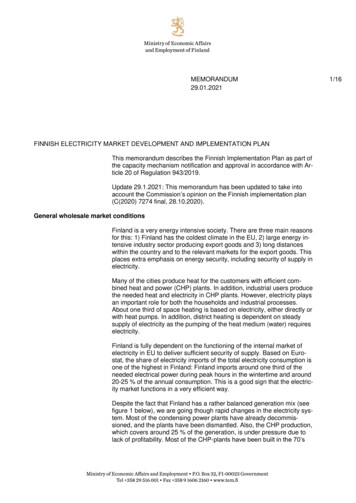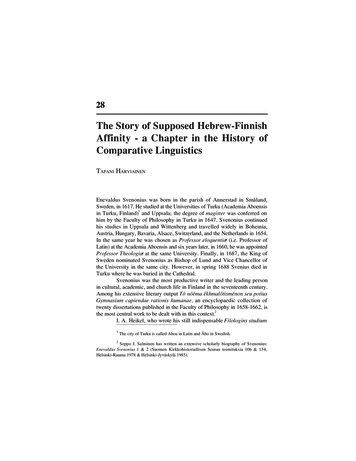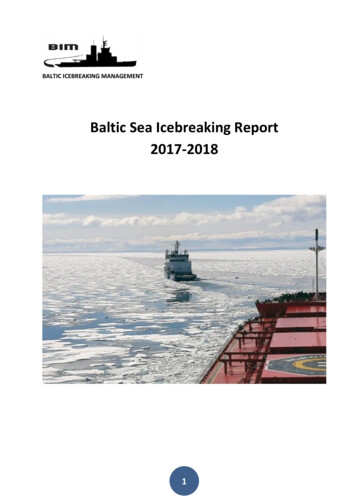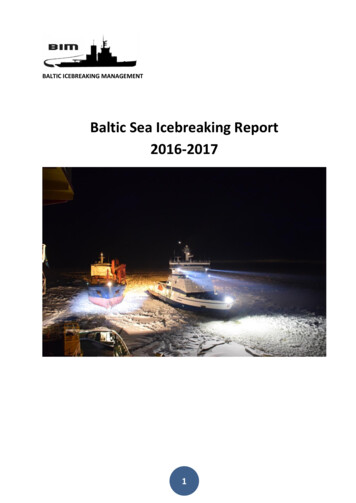
Transcription
MEMORANDUM29.01.2021FINNISH ELECTRICITY MARKET DEVELOPMENT AND IMPLEMENTATION PLANThis memorandum describes the Finnish Implementation Plan as part ofthe capacity mechanism notification and approval in accordance with Article 20 of Regulation 943/2019.Update 29.1.2021: This memorandum has been updated to take intoaccount the Commission’s opinion on the Finnish implementation plan(C(2020) 7274 final, 28.10.2020).General wholesale market conditionsFinland is a very energy intensive society. There are three main reasonsfor this: 1) Finland has the coldest climate in the EU, 2) large energy intensive industry sector producing export goods and 3) long distanceswithin the country and to the relevant markets for the export goods. Thisplaces extra emphasis on energy security, including security of supply inelectricity.Many of the cities produce heat for the customers with efficient combined heat and power (CHP) plants. In addition, industrial users producethe needed heat and electricity in CHP plants. However, electricity playsan important role for both the households and industrial processes.About one third of space heating is based on electricity, either directly orwith heat pumps. In addition, district heating is dependent on steadysupply of electricity as the pumping of the heat medium (water) requireselectricity.Finland is fully dependent on the functioning of the internal market ofelectricity in EU to deliver sufficient security of supply. Based on Eurostat, the share of electricity imports of the total electricity consumption isone of the highest in Finland: Finland imports around one third of theneeded electrical power during peak hours in the wintertime and around20-25 % of the annual consumption. This is a good sign that the electricity market functions in a very efficient way.Despite the fact that Finland has a rather balanced generation mix (seefigure 1 below), we are going though rapid changes in the electricity system. Most of the condensing power plants have already decommissioned, and the plants have been dismantled. Also, the CHP production,which covers around 25 % of the generation, is under pressure due tolack of profitability. Most of the CHP-plants have been built in the 70’s1/16
2/16and 80’s and are now coming in the age of renewal. Due to the currentelectricity market prices, most of the CHP plants will be replaced with biomass-fired heat-only boilers or large-scale heat pumps, thus reducinggenerating capacity or even increasing consumption during the times ofsystem stress. New generation capacity coming to the electricity systemincludes mostly wind power and nuclear power which are not well suitedfor dispatching for the system needs. In addition, there have been several delays on Olkiluoto 3 nuclear power plant (1600 MW), which is akey project for security of supply in Finland. Originally, the plant wassupposed to come online in 2009. During the consultation period of thisimplementation plan TVO published a further delay of the plant and nowthe latest estimate for the commission is February 20221. Due to this,Finland has been one of the leading countries in developing flexibility inthe electricity markets and taking new market concepts into operation.Figure 1. Electricity generation and imports in Finland in 2019 (consumption 86 TWh).Figure 2 shows estimated available generation capacity for winter 20192020 based on Energy Authority’s estimate2. Energy Authority estimatedthe available generation capacity in the markets to be 11 200 MW duringpeak demand and peak consumption to be 15 300 MW, leaving 4100MW to be covered with imports. Total import capacity is ca. 5100 MW ofwhich 1500 MW comes from a third country (Russia) meaning that under normal conditions the import capacity available within the internalenergy market during peak hour is 3700 MW. This already mean that ifno power were available from a third country, Finland would face a power deficit without a strategic reserve. In addition to the generation capacity in the markets, there is a strategic reserve of 729 MW, thus leavingdeficit of 3370 MW domestically. From July 2020 onwards the strategicreserve is 611 MW leaving domestic deficit of 3 490 MW.1Announcement of TVO of the latest postponement of commission date to February nofelectricitystartsinfebruary2022.htmll2 Electricity security of supply in 2019, report by Energy Authority 28.11.2019. Available in aportti-s%C3%A4hk%C3%B6ntoimitusvarmuus-2019.pdf
3/16Figure 2 also illustrates the importance of the CHP to the resource adequacy and the fact that there is hardly any condensing power plants leftin the electricity system. It should also be noted that there are no fastreacting gas turbines left in the wholesale market either and the last remaining condensing power plants run with solid fuels meaning slowramp up times.Figure 2. Available generation capacity winter season 2019-2020. Estimated peak demand 15 300 MW. ** Wind power availability 6%.Source: Energy AuthoritySince the consultation period of this report Energy Authority has published new report on the resource adequacy in winter 2020-20213. Thesituation is very similar to winter 2019-2020: the peak consumption isestimated to be 15 100 MW while available domestic generation capacity is estimated to be 10 800. This leaves 3 670 MW to be covered fromthe markets, including trade with third countries.Even though Finland has strong interconnections to the neighbouringcountries (total 5 100 MW compared to peak load of 15 300 MW), mostof the interconnector capacity (3 600 MW) is based on direct current(DC) technology. In this respect, Finland resembles an island. Alterningcurrent (AC) connections to Sweden connects Finland to the Nordicsynchronous system and are crucial for the operation of the Finnishelectricity system. Where DC interconnections can transmit energy, ACinterconnections provide instantaneous system services which areneeded in synchronous operation. Finland and Sweden have agreed toexpand the AC connection with new 800 MW overhead line by 20254.It is important to highlight that 1 500 MW of the import capacity comesfrom third countries, namely Russia. The commercial transmission capacity from Russia to Finland is 1300 MW and 320 MW from Finland toRussia. There are two modes of power trade between Russia and Finland: bilateral trade and so called direct trade. Fingrid and the Russianparties confirm the bilateral trade volumes for the next commercial day(D) on the morning of the previous day (D-1). The confirmed trade vol-3Electricity security of supply in 2020, report by Energy Authority 3.12.2020. Available in 70/13026619/S%C3%A4hk%C3%B6n toimitusvarmuus vuonna A4hk%C3%B6n toimitusvarmuus vuonna 2020.pdf?t 16069936784204 A third 400 kV AC interconnection to Sweden. Fingrid in nland--sweden/
4/16umes have to be bid into the day-ahead and intraday markets of theNordic Power Exchange. The volumes of the direct trade are determinedby the given bids on the day-ahead market and intraday market of theNordic Power Exchange and the corresponding Russian power markets.More information on trade on the FI-RU interconnector can be found onFingrid’s web page5. Finland has no intention to increase dependencyon third countries regarding security of supply of electricity.Because of high share of electrical heating, peak load hours coincideswith cold spells. In the wintertime, it is common that outside temperaturegoes down to -40 C. This causes immediate threat to human health andstructural damage to buildings and piping if there are interruptions in theelectricity supply. It is unacceptable to any society that no measureswould be taken to mitigate risks this magnitude. Politicians need assurance that there is a sufficient safety net if markets fail to deliver theneeded security of supply. Finland relies on the market mechanism toprovide security of supply and has taken the least intrusive approachwhen introducing the Peak Load Reserve originally in 2007.Description of day-ahead and intraday price formationIn Finland there are no formal or informal price limits in day ahead andintraday markets other than the technical limits currently applied withinEuropean single day-ahead and intraday coupling as set out in Article41(1) and 54(1) of Regulation 2015/1222 (CACM). There are also noformal or informal rules or requirements that limit generators’ ability tofreely price their offers in the wholesale markets, other than set in therequirements in Regulation 1227/2011 (REMIT), 2017/2196 (ER) and incase of a national emergency based on national Emergency Powers Act2011/1552. There are also no rules or provisions that would require theTSO to release generation reserves based on market prices.The purpose of Emergency Powers Act 2011/1552 is to give authoritiescertain extra powers in case of national emergencies. There are fivecategories for national emergencies: 1) an armed conflict or recoveryfrom an armed conflict, 2) a serious threat of armed conflict where additional powers are needed for authorities, 3) serious event or threat ofsuch event that can impair critical functions of the society, 4) especiallysevere disaster or recovery from such and 5) pandemic. First, the government has to declare the state of emergency based on the above categorisation, and only after that extra powers can be granted to authorities. Each extra powers have to be granted individually and only for alimited period.Energy-related extra powers are defined in 36§ -43§ and can be onlygiven during emergencies in categories 1 to 3. These powers relate torationing of heat, fuels and electricity for the customers and how muchthe price of these commodities can be increased.The legislation has been in place since 1991 and before that in sectorallegislation. During this time national emergency has only been declaredonce, during Covid-19 in March 2020. The state of emergency was declared based on category 3 and 5. The extra powers given were given5Cross-border Connections between Russia and Finland. Fingrid in tionsbetween-russia-and-finland/
5/16based on category 5 and related to securing the functioning of thehealthcare sector by e.g. exempting healthcare sector from certain provisions on employment legislation (overtime, vacations, requirement towork etc) and care of non-critical patients. The government declared in15.6.2020 that the current situation in the country no longer constituteda state of emergency and gave degrees to repeal the use of powers6.The basis for the Emergency Powers Act from EU law point of view isnational security. In accordance to Article 4 of the Treaty of the European Union (SEU) it belongs to the exclusive legal competence of theMember State. The Treaty of the Function of the European Function(TFEU) is also taken into account in the design and the Finnish legislation respects the principles set for national restrictions in the EU legislation (TEUF Articles 36, 45(3), 62 and 65(1)b) and jurisprudence of theEuropean Court of Justice for mandatory requirements. These derogations are applicable under normal circumstances for restrictions on internal market principles.Article 36 TFEU allows restriction on free movement of goods justifiedon grounds of e.g. public policy or public security or the protection of industrial and commercial property. Such prohibitions or restrictions shallnot, however, constitute a means of arbitrary discrimination or a disguised restriction on trade between Member States. According to theECT jurisprudence, the restrictions have to be non-economic. TheEmergency Powers Act also respects this principle.Regulation 2019/941 on risk-preparedness in the electricity sector isbased on Article 194(2) TFEU giving the EU legislation the possibility toadopt measures to ensure security of energy supply in the Union. Theprovision is based on the Treaty of the Function of the European Unionand is applied according to the internal market principles. The FinnishEmergency Powers Act rules for electricity on the other hand are applicable only when the conditions of Article 4 SEU i.e. threat to nation security occurs. It is primarily for the Member State to decide when theconditions are met. As the requirement is not easily fulfilled it can beconsidered that Risk-Prepardness regulation is the measure to safeguard security of supply in the EU and the national legislation is put inplace to safeguard national security.Current capacity mechanism scheme (power reserve)Finland employs a strategic reserve, the peak load reserve. The mechanism is based on Peak Load Reserve Act 117/2011. The peak load reserve capacity is used to ensure that the balance between supply anddemand can be achieved if the day-ahead market or balancing marketfails to reach a balance during winter period. However, the peak load reserve capacity is not allowed to participate and bid on the commercialmarket and it is activated only after the market does not reach balance.During the winter period, from December to end of February, powerplants participating in the peak load reserve system are in 12 hours’readiness to start electricity production. Rest of the time, power plantsare in one-month readiness. When in production, power plants selectedto the peak load reserve are required to be able to increase power attiistaina-16-kesakuuta?languageId en US
6/16put with 10 MW within 10 minutes after request and be ready for 200hours continuous power production with full capacity during the winterperiod. Demand side response (DSR) facilities are included in the peakload reserve during winter period from December to February. Duringthis period, DSR facilities shall be able to decrease load with 10 MWwithin 10 minutes after request.The Energy Authority is responsible for evaluating and deciding the required size of the peak load reserves and arranging the tendering process to procure the peak load capacity. Evaluation of the need for capacity is based on probabilistic methodologies (both Monte Carlo simulation and COPT-methodology) with which LOLE and ENS are estimated. For example ENTSO-E uses Monte Carlo simulations in their methodologies. The actual amount of capacity procured is based on the established need and the amount and price of the actual capacity tenders.During the period (from 1st of July 2017 until 30th of June 2020) thepeak-load reserve capacity consisted of four power plants (707 MW)and two demand-side response (DSR) facilities (22 MW). For the currentperiod from 1st of July 2020 until 30th June 2022 the reserve capacityconsists of three power plants (total 611 MW). DSR facilities were notcompetitive in this tendering round.Fingrid is responsible for making agreements with the selected powerplants and DSR facilities and pays the compensations to the powerplants which are financed by the fees collected from the Finnish electricity end-users. Energy Authority approves the operational agreements. The holders of the selected reserve capacity will receive fixedcompensation for providing the reserve capacity. If the reserve capacityneeds to be activated, only actual costs of the activation are remunerated to the capacity holders.The activation of the power plants will happen at the maximum price ofthe day-ahead market, at present EUR 3,000 per MWh. DSR facilitieswill be activated from the balancing market platform at the price of EUR3,000 per MWh (or at actual costs provided by capacity holder in tendering process if it is higher than EUR 3,000 per MWh).The Finnish and Swedish TSOs have agreed to coordinate the activation of their peak load reserve resources. The TSOs will activate strategic reserve resources in relation to the total reserve capacity in thecountries, if the situation in the electricity system allows this. In the current scheme, activation is done in the day-ahead timeframe if supplyand demand do not match. If the mismatch occurs only in one country,this would mean in normal conditions that the import capacity would bein full use and the reserve would have to be activated in the country ofdeficit. If there are simultaneous deficits, if there are other constraints inthe electricity system (e.g. faults which limit internal transmission capacity) or the deficit occurs after the day-ahead market and there is transmission capacity available the reserve could be activated also in anothercountry.Finland is currently revising the strategic reserve legislation to be in linewith the requirements in Regulation 943/2019.
7/16Balancing marketsThe Nordic countries established a common regulation power market in2002 to handle balancing needs. Within the market, imbalances arehandled and settled according to common rules defined in the SystemOperation Agreement between the Nordic TSOs. Balancing is managedwithin the Nordic control areas as one system consisting of all four Nordic TSOs. The balance management is based on frequency requirements and agreed in the System Operation Agreement. Even though thebalancing model is shared within the Nordics, there are some nationaldifferences in details.Figure 4 presents the balance management in the Nordic electricitymarket model. Besides actions of a specific operating hour in the regulation power market, Elbas-market can be used for intra-day trading andrevisions of nominations after the day-ahead market (Elspot) has closed.Figure 3. Balance management in the Nordic electricity market model(Source: Fingrid Oyj).In the Nordic regulation power market, all bids are collected into the jointNordic merit order list and in the order of the list the production increases and decreases are carried out where firstly, it is most advantageousand secondly in the price order of the bids, however, taking into accountcongestions between control areas. This leads to effective utilisation ofthe Nordic balancing resources.The balance between production and consumption within a specific operating hour is created through the regulation market by the upward anddownward regulation of production and consumption to handle physicalimbalances taking into account the effects on congestions.The price of the regulation power during the specified operating hour(the imbalance settlement period in Finland is 60 minutes) is determinedbased on ordered up- or down-regulations. This implies that the price ofthe regulating power is known only after the end of the specific operatinghour. It has been agreed, that the price of up-regulation is the most expensive up-regulation bid ordered by the TSO during the specific operating hour. All those who have participated in the up-regulation during thespecific operating hour receive the same compensation per MWh. Respectively the price of down-regulation is the cheapest down-regulationbid ordered by the TSO during the specific operating hour. All those whohave participated in the down-regulation during the specific operatinghour receive the same compensation per MWh.
8/16The TSO provides information on forecasts and values for the reservesbefore, during and after the operating hour and also regulation prices after the operating hour. Most of this information is given only to the market participants and to Nord Pool. Publicly available information can befound on Fingrid’s website www.fingrid.fi and Nord Pool’s websitewww.nordpoolgroup.com.The Finnish, Norwegian and Swedish TSOs decided in 2012 to implement a harmonised Nordic Balance Settlement model on the TSO level.The implementation includes harmonisation and integration of the national grid and bidding area level balance settlement. A common operational unit, eSett Oy responsible for imbalance settlement and invoicingof the Balance Responsible Parties in Finland, Sweden and Norway. It isjointly owned by the Finnish, Norwegian and Swedish TSOs while theDanish TSO is joining soon7. The project's goals have been firstly toprovide similar operating conditions to all balance responsible partiesdespite the area and country, secondly to offer balance settlement insimilar principles to all market participants through one unit and thirdly tocreate common rules and standards for data exchange in cooperationwith other actors in the electricity market. The go-live for the commonNordic Balance Settlement was on May 1, 2017.European Commission Regulation (EU) 2017/2195 establishing a guideline on electricity balancing requires that by 18 December 2020 all TSOsshall apply the imbalance settlement period of 15 minutes in all scheduling areas while ensuring that all boundaries of market time unit shall coincide with boundaries of the imbalance settlement period. The regulation allows that the national regulatory authority may, at the request ofthe TSO or at its own initiative, grant the relevant TSOs a derogationfrom this obligation until 1 January 2025. In October 2018, the EnergyAuthority published after an analysis and a consultation with neighbouring Estonian and Nordic NRAs a statement in which the Energy Authority did not find reasons for such derogation in Finland. In December2018, all Nordic NRAs published a similar joint statement. However, inMarch 2019 the Nordic TSOs announced that TSOs have identified arisk of delay in the implementation of the 15 min imbalance settlementperiod in the Nordics . In May 2020 the TSOs announced that they willjointly apply for a derogation until 22 May 2023. The TSOs sent requestsfor derogation to NRAs in June8 and the Nordic NRAs are now evaluating the request.In March 2018, all Nordic TSOs signed a Cooperation Agreement on aninitiative of the Nordic Balancing Model (NBM) to update and adapt thebalancing market design, develop methods and operational processesas well as related IT systems in order to ensure an efficient and securebalancing scheme compliant with the European network codes. TheNBM initiative will be based on the introduction of modernized AreaControl Error (mACE) in the Nordic LFC Block where instantaneouspower imbalance will be set to zero for each sub region (bidding zone)separately instead of present system where imbalance will be set forwhole Nordic synchronous area. The figure below describes theroadmap for these changes. According to the TSOs’ plans, the 1st generation of NBM will contain:7E-Sett: Denmark Go-Live commissioning plan, https://www.esett.com/denmark-go-live/Nordic TSOs: 15 minutes balancing period from 22 May -minutes-balancing-period-from-22-may-2023/8
9/16- Nordic aFRR capacity market- Nordic mFRR capacity market- Single price model- 15 minutes time resolution- mFRR balancing process automation (including changes to the mFRRenergy activationmarket)- Data & transparencyThe 2nd generation of NBM will contain:- European mFRR Standard product- aFRR energy activation market with European standard product- Full mACE model implementationFigure 4. Nordic Balance Settlement roadmap9Imbalance settlementFinland has had for long a balancing responsibility for all market participants. Act 588/2013 and degree 66/2009 set up the legal basis for imbalance settlement in Finland. Finland is also the first country in Europeto have carried out a full roll-out of smart meters to all customers included household customers (currently 99,8 % coverage of customers, 100% measured in energy) and mandated the use of hourly data for settlement purposes.Imbalance settlement rules are developed by the TSO and approved bythe NRA. These rules can be found on Fingrid’s web page10 and summarised below.The rules are the same for all parties, but in the Nordic countries there iscurrently a separate balance for production and consumption. For production, a two-price system is used and for consumption a one-pricesystem.In the two-price system, separate prices are calculated for the purchaseand sales of imbalance g-blocks/Fingrid, balancing services: ce-service/10
10/16Sales price of imbalance power: The price of imbalance power in theproduction balance sold by Fingrid to the balance responsible party isthe up-regulating price of the hour. If no up-regulation has been carriedout or if the hour has been defined as a down-regulating hour, the Finnish day ahead price is used as the sales price of imbalance power in theproduction balance.Purchase price of imbalance power: The price of imbalance power in theproduction balance purchased by Fingrid from the balance responsibleparty is the down-regulating price of the hour. If no down-regulation hasbeen carried out or if the hour has been defined as an up-regulatinghour, the Finnish day ahead price is used as the purchase price of imbalance power in the production balance.In the one-price system, the purchase and sales prices of imbalancepower are identical.During an up-regulating hour, the price of imbalance power is the upregulating price, and during a down-regulating hour, the price of imbalance power is the down-regulating price. If no regulations have beencarried out during an hour, the price of imbalance power is the Finnishday ahead price.In addition to the imbalance energy costs, there are weekly and volumetric fees for balancing services. The transmission system operator’sreserve costs account for the highest cost item in the balance service.There, reserves refer to those reserves which the TSO needs to maintain frequency and system security of the nation-wide transmission grid.The costs of the various types of reserves are allocated, using thematching principle, both to balance service and to other TSO services –primarily grid service – so that the costs of frequency-controlled normaloperation reserve belong to the balance service, and the disturbance reserves (frequency-controlled disturbance reserve and fast disturbancereserve) belong both to the balance service and other services. Theprinciple of dividing the costs of disturbance reserves is the same forboth reserves.The Nordic TSOs launched Fast Frequency Reserve in May 2020 tocontrol inertia in the electricity system. In order for the TSOs to launchthe reserves as soon as possible the markets are national. The goal forthe TSOs is to later work towards a common Nordic FFR market.11 Thecosts of Fast Frequency Reserve is collected from the grid service fees.11ENTSO-E:Fast Frequency Reserve–Solution to the Nordic inertia challenge, eserve-solutionto-the-nordic-inertia-challenge.pdf
11/16Figure 5. The division of costs between balance service and grid service.In situations where a TSO has to disconnect consumers involuntarily theimbalance settlement price is determined by the same rules as described above. However, the TSO has to first use all market-basedmeasures before disconnecting consumers which gives an indicationthat the price will be high.Scarcity pricing in balancingNordic balancing market has highly integrated balancing model andcommon market due the long history of close co-operation and voluntaryharmonisation, which goes beyond the current legal requirements. Nordic TSOs are in a process of establishment of the new Nordic balancingmodel (NBM) reflecting the requirements set in European legislation,which includes transition to the ACE-based balancing in 2024 and theapplication of the imbalance settlement period (ISP) of 15 minutes in2023 and common Nordic aFRR capacity markets in 2022.Figure 6 below illustrates the changes and steps of the Nordic TSOs inpreparation to the target model for imbalance settlement in the Nordics.First change is the introduction of the Single Price and Single Position in11/2021, to fulfil requirements of ISH due to ACER decision in 2020 tohave a common Nordic model. In order to minimize changes to the market participants, imbalance pricing and settlement will be kept as todayfor a limited interim period. Next step in the implementation timeline is tointroduce Nordic aFRR capacity market and Automated Nordic mFFRenergy market. In 2023 the Nordics will move to the 15 Minutes Imbalance Settlement Period, where imbalance pricing needs to be changedto take into account the new time resolution and new balancing products. These changes facilitate the implementation of ACE based modeland introduction of European MARI and Picasso platforms.
12/16Figure 6. Overview of up-coming changes in the Nordic level until 2024to imbalance settlement (non-exhaustive)Nordic TSOs are in progress to detail the changes seen for the 15-MinISP and ACE-based balancing model and introduction of shortage price.We believe that a common Nordic solution for shortage pricing shouldbe implemented, as common market rules creates better environmentfor the market participants to operate in all Nordic countries. To identifypossibility to implement solution solely in Finland, in case needed, Fingrid will start during 2021 with internal analysis of shortage pricing andfollow-up with stakeholder consultation. Thereafter Fingrid continues thework in year 2022 together with Svenska Kraftnät with the aim of havingaligned implementation plan and timetable to reflect also the possibilityto continue the current strategic reserves co-operation between Finlandand Sweden.Value of lost loadAt the moment there is no single official estimate for the va
umes have to be bid into the day-ahead and intraday markets of the Nordic Power Exchange. The volumes of the direct trade are determined by the given bids on the day-ahead market and intraday market of the Nordic Power Exchange and the corresponding Russian power markets. More information on trade on the FI-RU interconnector can be found on










